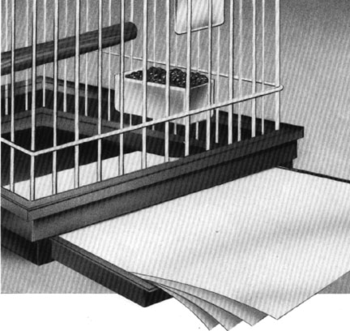This question always seems to pop up when bird enthusiasts just get started in the care and keeping of their feathered friends. What cage liner is best to use? What is the cheapest method, and which is the safest? There are so many products (some misleading) that it can certainly lead you in obscure, not to mention potentially hazardous, directions. Let’s separate fact from fiction.
When first deciding what sort of liner to use consider your cage. Is the tray an odd shape? Does your cage have a grate to prevent your bird from tracking around the bottom? Can the bird reach the bottom with the gratein place? The answers to these questions will help determine which sort of liner is best suited for your situation. You want to pick a liner that can be easily examined, as a change in your birds droppings can be an indicator of illness. You want to choose a product that will make it easy to see the consistency, color, shape, and number of droppings. You also want a liner that will be easy to maintain and will not allow droppings, water, or other messy substances to permeate and cause potential mold issues.
Common Beddings on the Market Today Include:
Corn Cob Bedding while often marketed for pets and birds in particular, this product can cause more hazard then harm. Because it is so absorbent it can easily mold. The dust produced from the corn cob also has the potential to create respiratory issues in sensitive birds. If your bird has any access to his cage bottom at all, corn cob can pose a hazard if your bird accidentally ingests any of it.
Walnut Shells are another bedding type that is easy to come by, and at one time or another has been recommended as OK for birds. Walnut shells when eaten can irritate and inflame organs, causing discomfort, or even internal damage. Walnut shells are not recommended for avians.
Cedar Shavings can contain ingredients and natural oils that are toxic to birds. Their strong aroma can cause respiratory discomfort which can lead to allergic symptoms and irritation of the digestive track. Also, any sort of wood shavings are not ideal for ‘broody’ or ‘nesty’ female birds.
Pine Shavings unlike cedar are not toxic and are quite often used as nesting material for birds. We suggest using pine shavings for nesting material, but not as a bedding for the cage bottom. Shavings can increase hormonal behavior in female parrots especially if they have access to the shavings. If shavings are eaten crop impaction is another concern. If your bird is a bather, shavings are not recommended as they can easily harvest mold when wet.
Kitty Litter. I’ve heard of few owners using kitty litter in the bottom of the birds cage. The dust factor that is associated with litter alone makes using kitty litter a hugenegative issue. Clumping litter contains ingredients to make the litter swell, sometimes to ten times its normal size. So if ingested it poses a huge health hazard to your bird.
Paper Products are seemingly the all around winner when it comes to cage liners. Easy to come by … I’ve heard of owners getting their paper from neighbors, buying end rolls from their local newspaper, and everything in between! Newspaper is probably the most commonly used cage liner. In the US all newspapers use a soy based ink which is safe for your bird in case it has access to the bottom of his cage. Actually soy based ink is said to have antibacterial properties, so it’s a healthy way to line your cage and ward off unwanted bacteria. It also has a slim risk for molding and is easy to clean.

Cage Catchers
Cage Catchers and KageLiners are two bird-safe alternatives currently available that have recently been getting a lot of praise. Cage Catchers is a brand name for a paper that is lightly waxed on one side which makes it better that newspaper since the waxed surface deters moisture absorption. This not only is healthier for your bird but helps protect cage trays from excessive moisture which often leads to metal tray damage. Cage Catchers come in many sizes and can even be custom cut to your specifications. A wallet-friendly alternative to paper, they make cleaning your cage easy and pain free. Cage Catchers, like paper, harbor little possibility for mold and give little opportunity for unwanted bacteria to fester.
Other beneficial products to consider are: Neater Tweeter Mess Magnet, Luv My Birdie Litter.
Whatever you decide to use please make sure what you use is safe for your bird. We’ve heard owners using just about everything in their cages — from paper towels to aluminum foil (a big no!), even including fleece that is swapped out and washed daily. Whatever fits your cage, your budget, and your bird is what will be best for you! We recommend contacting your local newspaper to see if you can strike a bargain for their recyclables, or even the end rolls. If that isn’t possible, don’t forget the Cage Catchers … they are an ideal choice!
If you are looking to cut down on bird debris and mess, we also recommend checking out this great line of seed catchers, excellent products for small bird table-top cages.